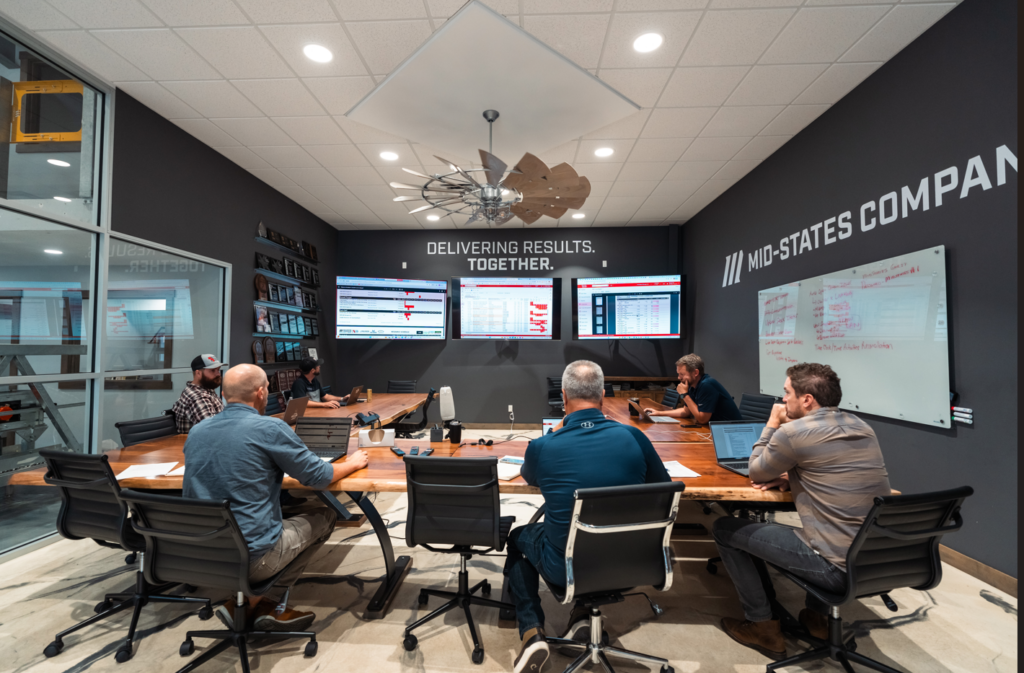Strategies Group Helps Mid-States Companies Digitally Transform with Acumatica Construction Edition
Download the Full Case Study

About Mid-States Companies
Company Website:
Industry
Construction, Manufacturing, Agriculture & Farming
Apps Replaced
QuickBooks
Number of Employees
Approx. 90 full time employees
Location
Nevada, Iowa
Products
Acumatica Advanced Construction Edition with:
- Advanced Job Cost Accounting
- Multiple Company and Intercompany Accounting
- Inventory Control
- Order Management
- Acumatica Payroll

See How Mid-States Modernized Their Business
Mid-States Companies, a leader in the construction industry, was looking for a way to unify their financial and operational data, improve reporting accuracy, and scale efficiently. With Acumatica Construction Edition and the expert guidance of Strategies Group, they transformed their business—streamlining workflows, enhancing team training, and gaining real-time visibility into their operations.
Their success hasn’t gone unnoticed. Named Acumatica’s 2025 Construction Customer of the Year, Mid-States has become a power user of the system, sharing their expertise and best practices at industry events, including multiple presentations at Acumatica Summit.
Download the case study to learn how Mid-States leveraged Acumatica and Strategies Group to drive efficiency, growth, and industry leadership.
A Deep Dive into IOC's Connected Solution
In August 2020, Iowa and several Midwest states were hit with a powerful land hurricane known as a derecho, an unprecedented storm that resulted in $11.9 billion in damages across the region. The storm’s mini-tornados, flooding and hail hit a swath of rich agricultural land across 90,000 square miles and flattened grain silos, hay storage facilities, barns and destroyed millions of dollars of agricultural equipment.
Although devastating, the destruction offered an enormous opportunity for many construction firms. Among them was Nevada, Iowa-based Mid-States Companies, a collection of firms offering design and engineering, millwright, building, material handling equipment, crane, and trucking services to agriculture operations and other industries.
“The storm destroyed millions of bushels of storage in a matter of hours,” says Andrew Pistorius, Mid-States Chief Financial Officer, adding many of the grain silos recently built were expected to last 50 years or more. “Everything had to get rebuilt quickly. All of a sudden, we had all this work to do.”
Operating on QuickBooks and JobBOSS, executives knew increasing their workloads by more than 50 percent would be challenging at best. “This was a catalyst moment for us where we had to figure out how to do more work than we’d ever done,” Pistorius says. “But what it did was it turned us into a different company because we realized we could do a lot more when we leveraged other strategies.”
Mid-States deployed new labor strategies, changed how it worked with subcontractors, and invested in a digital transformation. Revenue the year following the derecho jumped by $30 million. The transition, however, wasn’t easy.
Throughout its first two decades, family-owned Mid-States ran on QuickBooks, the basic entry-level financial package that many small firms use when they begin operations. Over time, the company grew quickly, adding a number of construction-related services. It is now comprised of at least 12 companies. Rather than spending what is often perceived as a more than $1 million investment in a traditional enterprise-level ERP, Mid-States augmented QuickBooks with many, many spreadsheets.
Eventually, operating on spreadsheets and trying to run its manufacturing operations on the scheduling program named JobBOSS, became unwieldy and inefficient.
To quote a project, employees used individually created spreadsheets to calculate costs, which could take much of a day.
They then took another day to create an actual bid, using their own personally made spreadsheets. When changes were suggested by a customer, they would update the spreadsheets and email additional changes back and forth. All this information was stored locally on the employee’s computer.
“We didn’t have any way to track where each bid or project was at,” says Pistorius. To learn how many bids were outstanding, which ones were good opportunities, which ones were re-priced or even the total project revenue amounts anticipated meant one-off conversations with the sales team. “It was very people-based, not process-based.”
The construction edition of QuickBooks was fine for accounting, but not for project accounting or analysis, Pistorius says.
“It’s not built for management. It can account for your projects, but it’s not going to help you schedule, it’s not going to help you create new systems to be able to track compliance or things like that.” In addition, only the outside accountant had access to the data, so if Pistorius wanted a report, for example, she was needed to run it. “There was no ability to self-serve and do analysis, and then consolidate data and forecast,” says Pistorius.
Other executives also needed data and analysis capabilities that QuickBooks didn’t provide.
“This is a really simple example, but if Austin, who is our chief operating officer, wanted to know what our net revenue was for the year, I had to go run four reports in QuickBooks and then do the net elimination because the data wasn’t integrated and we didn’t have any sort of intercompany tracking or a system that could do that,” Pistorius says. Because there was only the basic financial system, they didn’t have access to data such as man-hours worked in a week, work in progress, or man-hour efficiency. “There was no statistical system,” he says.
The manufacturing side of the business was using JobBOSS and QuickBooks, and lacked operational visibility. “JobBOSS was very clearly written for Windows XP and was very inflexible,” says Pistorius who used SAP products at prior companies. QuickBooks custom reporting carried expensive consulting fees, and the standard reports didn’t contain the information he wanted. “It got to the point where there weren’t enough controls or systems and we needed to have project budgets that weren’t in spreadsheets,” Pistorius says. “It just wasn’t going to work. We needed to know where we were at before the end of a job.”
“We had no way of knowing where we were on a job relative to how it was estimated unless a guy pulled up his spreadsheet that was saved to his computer,” he adds. “And when we needed to build a job, we didn’t have that spreadsheet. So, we didn’t know what he sold it at, and we didn’t know if it was a fixed-price job. We knew we had given the customer a bid, but we didn’t know what was agreed upon. We didn’t have a place to store the document relative to the job so that you could get back to it quickly. We had many problems, probably more than we knew.”
The systems Mid-States had didn’t allow for any automation, nor could QuickBooks handle manufacturing exceptions.
The storm and huge opportunity highlighted the need for a better financial platform, Pistorius says.
Mid-States wanted an affordable, cloud-based construction platform that offered inventory capabilities, and narrowed the list to Sage Intacct and Acumatica. Sage’s construction solution, however, couldn’t handle the inventory functionality Mid-States needed and it also charged per-user licensing fees, which hinders a company’s growth. “The more I looked at Acumatica and how it worked, the more confident I was that it would work for us,” Pistorius says.
“Mid-States deployed Acumatica Construction Edition, a comprehensive, cloud ERP platform that includes job costing, construction project management, contract and change order management, subcontractor bidding and payment, and AIA invoicing. They also implemented modules for Inventory, Payroll, and Retainage and third-party application Velixo, which provides extended reporting and budgeting.
“One of the things that I appreciate most about Acumatica is that (pricing) is based on transactions, not per user,” says Pistorius. “I don’t care for per-user vendors because the problem with that is it incentivizes me to have as few users as possible. And the best results you’ll get from an ERP is having the most users.”
Because Acumatica offers cross-industry functionality, and takes a flexible approach to meeting a company’s needs, Mid-States added Acumatica’s inventory module, which is useful in its manufacturing company. “Being able to utilize functionality from other industry editions is going to enable us to do stuff that we wouldn’t have been able to if we had gone with the purely Construction edition,” says Pistorius.”
Mid-States worked with Strategies Group to train users, customize the system and provide day-to-day support for its Acumatica system. Based in Atlanta, GA with customers nationwide, Strategies Group began supporting Acumatica eight years ago after looking for a future-looking next-generation platform for construction. President Daniel Collins says while the 40-year-old company specializes in construction, the team’s vast ERP and business experience includes manufacturing, distribution, field service, and inventory management expertise, which many construction firms often need.
Mid-States, Collins says, needed a very flexible platform that not only supported its construction businesses, but some of the other operations the company owns, which include a fabrication shop and a car wash, among other endeavors.
With Acumatica deployed, Pistorius runs consolidated financial statements with a click of a button. “Anytime I want, so I can get a P&L and it tells me my net profit and my net revenue, net of intercompany eliminations, immediately,” he says. He also tracks opportunities and sales in real time. “The only thing we were doing to systematically track sales was we had a Google sheet that contained the customer’s name, the location, and the dollar amount. We looked at it every week and then we would just delete it when it was no longer an opportunity. What happened to it then? I don’t know.”
Previously, Mid-States’ executives only tried to consolidate financial operations for two of its entities, partly because of how fast the company was growing. “I didn’t even have access to that QuickBooks file, which was at our CPA’s office,” Pistorius says. “I couldn’t even look at it. But now I can click a button and run those consolidated financials.” Mid-States now has 12 operational entities and he runs reports instantly on any one at any time with Acumatica’s intercompany module.
Flexible System Improves Productivity
Pistorius likes Acumatica’s flexibility, which allows him and others to customize the platform without being software developers. “I’m a nerd, but I’m not a programmer,” he says. “There’s a whole bunch of personalization that I’ve done in Acumatica with Strategies Group that has really helped our business tremendously.”
For example, Pistorius set up an automation schedule that emails a daily report to several project managers for their review. He also used Acumatica’s project management module to create dozens of custom forms for the field services team, which saved them a lot of time. Those and other forms utilize some 900 attributes he created that are specific to company operations.
“We have a job safety analysis that they used to fill out on either Google Sheets, Google Forms or Microsoft Forms,” he explains. “All of those products are terrible because the data’s not as easy to analyze. The end product that you get from it is not pretty, and it’s not something you’d want to hand to a customer or subcontractor or vendor.”
Now Mid-States presents clean, company-branded PDFs that can automatically be sent to a customer, a vendor, or a subcontractor. “It has changed the way we think about how we collect data from the field because now the guys just pull up their phone, they add a new project issue, they select the right class, and then all the questions they need to answer to fill out the form are there.”
Adds Strategies Group’s Collins, “Mid-States has some of the prettiest reports I’ve ever seen, mainly because Andrew builds all of his report formatting and he’s very adamant about it being right. They do a lot of really cool things with the platform’s business events, automations and generic inquiries.”
For example, many forms now have dropdown menus so employees don’t have to type in answers, and projects can be selected, which auto-populates basic information into the form. Employees upload information regarding on-site inspections that are automatically sent to the project manager and safety director, and then stored for future retrieval.
“As we have grown as an organization, the ability to distribute the data out to the right person at the right time has been really beneficial,” says Pistorius. “The estimating and proposal workflows have been a real win.” The company also tracks opportunities in a project conversion report, and better understands future workflows.
Deep Data for Construction
“Acumatica is a great fit for the construction industry because of the data you can get out of the system,” says Collins. “Most people put their data into the system and they just say, okay, it’s my accounting, it’s my GL, and leave it like that.” Pistorius, however, has taken a higher level operational approach to leveraging as much data as he wants.
“What Acumatica really does very well is allows you to pull anything you want in the system and report on it, which makes it actionable,” Collins says. “It makes it actionable; it makes it in real time, and it makes it something that you can make business decisions on. It’s so easy to get data out of Acumatica that you don’t have to be a developer. You can get what you want out of the system with a few easy clicks.”
Because he wants to leverage Acumatica’s flexible personalization features to a fuller extent, Pistorius has held several on-site engagements with Strategies Group, which resulted in streamlined custom forms and a more polished estimate and quote system. “The amount of work we’ve gotten done in those onsite engagements has been really, really incredible, and allows us to tailor Acumatica,” Pistorius says. “Strategies has been a really, really good partner. They’re responsive and very creative. They always tell me I give them really difficult problems to solve, but they’ve been really helpful.”
“Our VAR relationship is something that I really value because it allows us to work more closely with a firm that understands our business. Building custom forms inside of Acumatica has been one of the biggest wins for us because it simplified a complicated part of our business. Our estimate proposals are also a win. Almost everybody else still estimates in Excel or writes proposals in Word, but we don’t have to do that.”
Continued Growth
Mid-States has only scratched the surface of what Acumatica can do, and the construction firm’s digital transformation is just getting started, Pistorius says. “Acumatica as a system is allowing us to become a more process-based organization,” he says. Being processed-based will allow Mid-States “to scale at whatever rate is most appropriate, and in a way that’s prudent, profitable, and ultimately beneficial to our staff and our customers.”
Mid-States Companies Named Construction Customer of the Year
Mid-States Companies has been recognized as Acumatica’s 2025 Construction Customer of the Year, a testament to their commitment to operational excellence and technology-driven growth. As power users of Acumatica Construction Edition, Mid-States has fully embraced the platform, leveraging its capabilities to streamline workflows, improve financial visibility, and scale their business efficiently.
Beyond their internal success, Mid-States has emerged as an industry leader, sharing their expertise with the broader Acumatica community. Andrew Pistorius and Dan Hunting from the Mid-States team have presented at multiple sessions during Acumatica Summit, showcasing innovative ways to maximize the Construction Edition. Their leadership and willingness to help others make them a valuable resource for fellow construction professionals looking to enhance their ERP strategy.
Through their partnership with Strategies Group, Mid-States has optimized processes, enhanced team training, and maximized the value of their ERP investment. Their innovative approach to construction technology continues to set a high standard for the industry.



